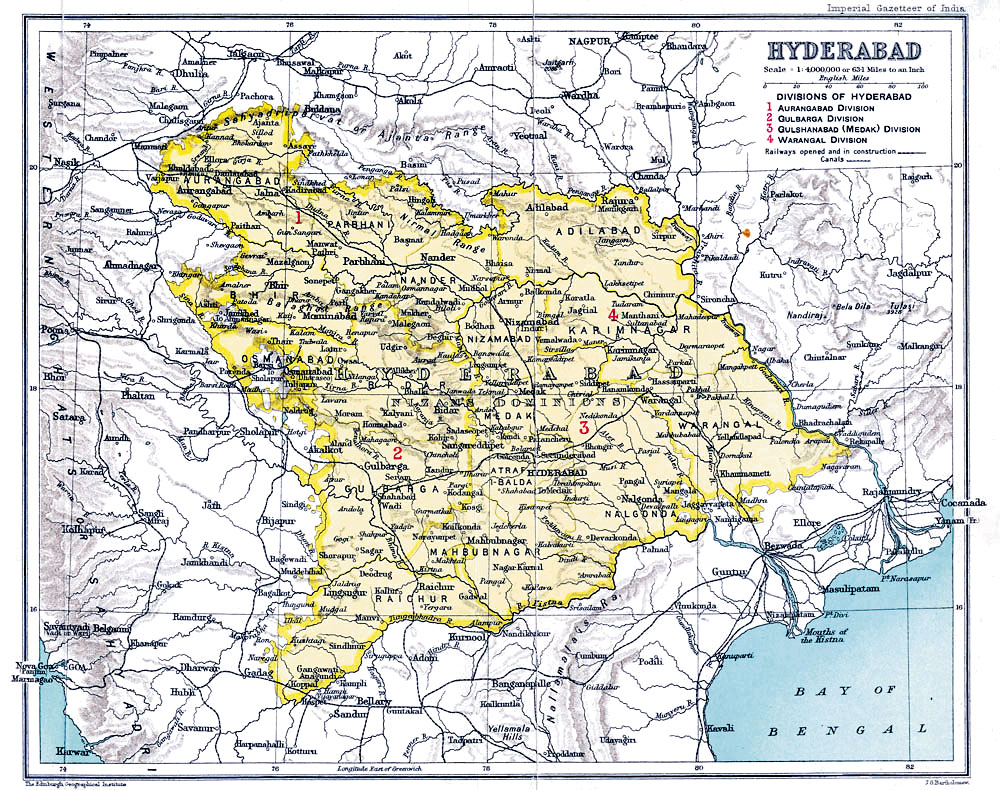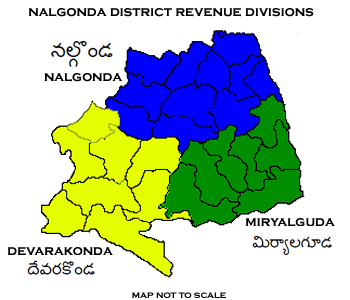|
Telangana Rebellion
The Telangana Rebellion popularly known as Telangana Sayuda Poratam (Telugu : తెలంగాణ సాయుధ పోరాటం) of 1946–51 was a communist-led insurrection of peasants against the princely state of Hyderabad in the region of Telangana that escalated out of agitations in 1944–46. Hyderabad was a feudal monarchy where most of the land was concentrated in the hands of landed aristocrats known as Doras in Telangana. Feudal exploitation in the region was more severe compared to others of India; the had complete power over the peasants and could subject them to agricultural slavery. Conditions worsened during the 1930s due to the Great Depression and a transition towards commercial crops. In the 1940s, the peasants started turning towards communism, organised themselves through the Andhra Mahasabha and began a rights movement. catalyzed by a food crisis that affected the region following the end of the Second World War, the movement escalated into a reb ... [...More Info...] [...Related Items...] OR: [Wikipedia] [Google] [Baidu] |
Cold War
The Cold War is a term commonly used to refer to a period of geopolitical tension between the United States and the Soviet Union and their respective allies, the Western Bloc and the Eastern Bloc. The term '' cold war'' is used because there was no large-scale fighting directly between the two superpowers, but they each supported major regional conflicts known as proxy wars. The conflict was based around the ideological and geopolitical struggle for global influence by these two superpowers, following their temporary alliance and victory against Nazi Germany and Imperial Japan in 1945. Aside from the nuclear arsenal development and conventional military deployment, the struggle for dominance was expressed via indirect means such as psychological warfare, propaganda campaigns, espionage, far-reaching embargoes, rivalry at sports events, and technological competitions such as the Space Race. The Western Bloc was led by the United States as well as a number of other First W ... [...More Info...] [...Related Items...] OR: [Wikipedia] [Google] [Baidu] |
Rajpramukh
Rajpramukh was an administrative title in India which existed from India's independence in 1947 until 1956. Rajpramukhs were the appointed governors of certain Indian provinces and states. Background The British Indian Empire, which included most of present-day India, Pakistan, and Bangladesh, was made up of two types of political units. British India consisted of fifteen provinces, all British possessions, ruled directly by the British in all respects, either through a governor or a chief commissioner, officials appointed by the viceroy. Existing alongside British India were a large number of princely states, ruled by local hereditary rulers, who acknowledged British suzerainty, including British control of their external affairs, but who retained local autonomy. At the time of the proclamation of Queen Victoria as Empress of India in 1875, more than 700 Indian princely states and territories enjoyed treaty relations with the British Crown. The exact relationship between th ... [...More Info...] [...Related Items...] OR: [Wikipedia] [Google] [Baidu] |
Caste System In India
The caste system in India is the paradigmatic ethnographic example of classification of castes. It has its origins in Outline of ancient India, ancient India, and was transformed by various ruling elites in medieval, early-modern, and modern India, especially the Mughal Empire and the British Raj. It is today the basis of Reservation in India, affirmative action programmes in India as enforced through constitution of India, its constitution. The caste system consists of two different concepts, ''Varna (Hinduism), varna'' and ''Jāti, jati'', which may be regarded as different levels of analysis of this system. Based on DNA analysis, endogamous i.e. non-intermarrying Jatis originated during the Gupta Empire. Our modern understanding of caste as an institution in India has been influenced by the collapse of the Mughal era and the rise of the British Raj, British colonial government in India. The collapse of the Mughal era saw the rise of powerful men who associated themselves w ... [...More Info...] [...Related Items...] OR: [Wikipedia] [Google] [Baidu] |
Social Revolution
Social revolutions are sudden changes in the structure and nature of society. These revolutions are usually recognized as having transformed society, economy, culture, philosophy, and technology along with but more than just the political systems. Overview Theda Skocpol in her article "France, Russia, China: A Structural Analysis of Social Revolutions" states that social revolution is a "combination of thoroughgoing structural transformation and massive class upheavals".Skocpol, Theda. 1979. States and Social Revolutions: A Comparative Analysis of France, Russia and China. Cambridge: Cambridge University Press., p. 173 She comes to this definition by combining Samuel P. Huntington's definition that it "is a rapid, fundamental, and violent domestic change in the dominant values and myths of society, in its political institutions, social structure, leadership, and government activities and policies" and Vladimir Lenin's, which is that revolutions are "the festivals of the oppres ... [...More Info...] [...Related Items...] OR: [Wikipedia] [Google] [Baidu] |
Communes
An intentional community is a voluntary residential community which is designed to have a high degree of social cohesion and teamwork from the start. The members of an intentional community typically hold a common social, political, religious, or spiritual vision, and typically share responsibilities and property. This way of life is sometimes characterized as an "alternative lifestyle". Intentional communities can be seen as social experiments or communal experiments. The multitude of intentional communities includes collective households, cohousing communities, coliving, ecovillages, monasteries, survivalist retreats, kibbutzim, hutterites, ashrams, and housing cooperatives. History Ashrams are likely the earliest intentional communities founded around 1500 BCE, while Buddhist monasteries appeared around 500 BCE. Pythagoras founded an intellectual vegetarian commune in about 525 BCE in southern Italy. Hundreds of modern intentional communities were formed across Europe ... [...More Info...] [...Related Items...] OR: [Wikipedia] [Google] [Baidu] |
Rout
A rout is a panicked, disorderly and undisciplined retreat of troops from a battlefield, following a collapse in a given unit's command authority, unit cohesion and combat morale (''esprit de corps''). History Historically, lightly-equipped soldiers such as light cavalry, auxiliaries, partisans or militia were important when pursuing a fast-moving, defeated enemy force and could often keep up the pursuit into the following day, causing the routed army heavy casualties or total dissolution. The slower moving heavy forces could then either seize objectives or pursue at leisure. However, with the advent of armoured warfare and '' blitzkrieg'' style operations, an enemy army could be kept more or less in a routed or disorganized state for days or weeks on end. In modern times, a routed formation will often cause a complete breakdown in the entire front, enabling the organized foe to attain a quick and decisive victory in the campaign. In the blitzkrieg warfare that charact ... [...More Info...] [...Related Items...] OR: [Wikipedia] [Google] [Baidu] |
Hyderabad State Forces
The Hyderabad State Forces were the armed forces of the princely state of Hyderabad State, Hyderabad. People from both India and abroad were recruited into the Forces. Among these groups were Arab nationals like Chaush (India), Chaush and African nationals like Siddi#Hyderabad, Siddi's who now stay in Barkas, Hyderabad, Barkas and A.C. Guards areas of present Hyderabad respectively. The Hyderabad cavalry was chiefly composed of Muslim castes such as Mughals, Pathans, Syeds, Sheikhs and Balochs. Afghan And Pathan's Are joined militry who are migrated from present day Afghanistan,pakistan and Kashmir.They were principally recruited from the Deccan plateau, Deccan, but Old Delhi, Delhi, Lucknow, Shahjahanpur, Sindh and Balochistan also supplied recruits to bolster ranks. These non-indigenous soldiers were called as "Rohollas". The Hindus made a very small portion of the cavalry. The Nizam of Hyderabad also had about 1200 Sikh guards. Other battalions within the army were called line " ... [...More Info...] [...Related Items...] OR: [Wikipedia] [Google] [Baidu] |
Nalgonda District
Nalgonda district is a district in the Telangana state of India. Nalgonda district has the highest number of mandals in the state with 31 mandals. The district shares boundaries with Suryapet, Rangareddy, Yadadri and Nagarkurnool districts and with the state boundary of Andhra Pradesh. Etymology Nalgonda is derived from two Telugu words Nalla (Black) & Konda (Hills) i.e. ''Black Hills''. History Nalgonda was earlier referred to as Neelagiri, the name given by some local rulers and the name was changed to ''Nallagonda'' only after its conquest by Allauddin Bahaman Shah, the founder of Bahmani Sultanate . The district had a major role in the Telangana Rebellion. Geography The district is spread over an area of . Demographics Census of India, the district has a population of 1,618,416. According to the 2011 census, 81.75% of the population spoke Telugu, 11.91% Lambadi and 5.51% Urdu as their first language. The Krishna River, Musi River, Aleru, Peddav ... [...More Info...] [...Related Items...] OR: [Wikipedia] [Google] [Baidu] |
Warangal District
Warangal district, formerly Warangal Rural district, is a district in the Indian state of Telangana. The district shares boundaries with Mahabubabad, Jangaon, Hanamkonda, Mulugu and Bhupalpally districts. As of June 2021, Hanamkonda tentatively serves as the district headquarters of both Hanamkonda and Warangal districts. Warangal city is proposed to replace Hanamkonda as the new headquarters of the Warangal district. The district was formed in 2016 by carving out Warangal Rural district from the erstwhile Warangal district. In August 2021, the Warangal Rural district was renamed back to Warangal district. Warangal and Khila Warangal mandals are transferred to the newly-formed Warangal district. History Erstwhile Warangal district consisted of many prehistoric habitation sites, which were explored by the Indian archaeological authorities. Paleolithic Rock art paintings are found at ''Pandavula gutta''http://www.aparchaeologymuseum.com/wp-content/uploads/2012/05/Warangal ... [...More Info...] [...Related Items...] OR: [Wikipedia] [Google] [Baidu] |
Second World War
World War II or the Second World War, often abbreviated as WWII or WW2, was a world war that lasted from 1939 to 1945. It involved the vast majority of the world's countries—including all of the great powers—forming two opposing military alliances: the Allies and the Axis powers. World War II was a total war that directly involved more than 100 million personnel from more than 30 countries. The major participants in the war threw their entire economic, industrial, and scientific capabilities behind the war effort, blurring the distinction between civilian and military resources. Aircraft played a major role in the conflict, enabling the strategic bombing of population centres and deploying the only two nuclear weapons ever used in war. World War II was by far the deadliest conflict in human history; it resulted in 70 to 85 million fatalities, mostly among civilians. Tens of millions died due to genocides (including the Holocaust), starvation, ma ... [...More Info...] [...Related Items...] OR: [Wikipedia] [Google] [Baidu] |
Commercial Crop
A cash crop or profit crop is an agricultural crop which is grown to sell for profit. It is typically purchased by parties separate from a farm. The term is used to differentiate marketed crops from staple crop (or "subsistence crop") in subsistence agriculture, which are those fed to the producer's own livestock or grown as food for the producer's family. In earlier times, cash crops were usually only a small (but vital) part of a farm's total yield, while today, especially in developed countries and among smallholders almost all crops are mainly grown for revenue. In the least developed countries, cash crops are usually crops which attract demand in more developed nations, and hence have some export value. Prices for major cash crops are set in international trade markets with global scope, with some local variation (termed as "basis") based on freight costs and local supply and demand balance. A consequence of this is that a nation, region, or individual producer relying on s ... [...More Info...] [...Related Items...] OR: [Wikipedia] [Google] [Baidu] |

.png)






_District_Revenue_divisions.png)

